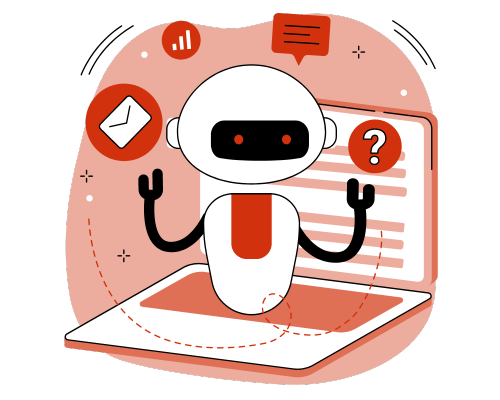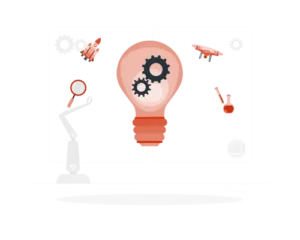The digital transformation wave is sweeping across industries, bringing AI (Artificial Intelligence) and RPA (Robotic Process Automation) to the forefront. As businesses seek to enhance efficiency, productivity, and innovation, understanding the best technological approach becomes crucial. But which is the better option: AI or RPA?
In this blog, we’ll explore:
- The definitions of AI and RPA
- The key distinctions between AI and RPA
- Benefits of AI and RPA
- Integration Possibilities of AI and RPA
- Some ideal use cases of AI and RPA
What is AI?
Artificial Intelligence (AI) is a branch of computer science that aims to create machines capable of performing tasks that typically require human intelligence. These tasks include learning, reasoning, problem-solving, perception, and language understanding. AI systems are designed to mimic human cognitive functions and can be classified into narrow AI (designed for specific tasks) and general AI (possessing broader cognitive abilities).
Key Features and Capabilities of AI
- Machine Learning (ML): Machine Learning is a type of Artificial Intelligence (AI) that learns from data. It looks at large amounts of data, finds patterns, and makes decisions or predictions. Over time, it gets better at these tasks as it processes more data, without needing new programming or human help. This makes ML very useful for many tasks, like understanding language or recognizing images.
- Natural Language Processing (NLP): This field includes the methods that help computers understand, interpret, and create human language. It involves tasks like recognizing speech, generating text, translating languages, and analyzing feelings in text. NLP helps computers and humans communicate in a natural and easy way.
- Computer Vision: The ability of machines to see and understand images and videos. This field creates programs that help computers recognize objects, detect items, and understand scenes. It aims to make computers see and understand the world like humans do.
Examples of AI Applications
- Healthcare: AI in healthcare aids in better diagnostic systems for early and accurate disease detection, personalized medicine that customizes treatments based on a person’s genes, and robotic surgeries that improve precision and speed up recovery.
- Finance: AI in finance includes various applications such as fraud detection to prevent financial crimes, algorithmic trading that uses complex algorithms to execute trades at optimal times, and customer service chatbots that offer automated assistance to clients, enhancing their overall experience.
- Manufacturing: AI in manufacturing aids in predictive maintenance, using advanced technologies to predict when machinery needs maintenance and prevent unexpected breakdowns. It also ensures quality control by making sure products meet standards through rigorous testing and inspection. Additionally, automating production processes streamlines operations, reduces labor costs, and increases efficiency with robotics and advanced software systems.
What is RPA?
Robotic Process Automation (RPA) is a technology that allows organizations to automate repetitive, rule-based tasks by using software robots or “bots.” RPA mimics human actions interacting with digital systems and software to perform tasks such as data entry, transaction processing, and report generation.
Key Features and Capabilities of RPA
- Rule-Based Automation: Robotic Process Automation (RPA) is designed to perform tasks according to a set of predefined rules and workflows. It involves creating specific guidelines and procedures that the system follows to execute various tasks efficiently. These rules are established in advance and dictate how the automation process should handle different scenarios, ensuring consistency and reliability in task execution.
- User Interface Interaction: Bots can interact with various applications and systems in a manner similar to how a human would. This includes navigating through menus, clicking buttons, filling out forms, and even responding to prompts or error messages. By mimicking human actions, bots can effectively streamline tasks and improve efficiency across different platforms.
- Non-Invasive Integration: One of the significant advantages of Robotic Process Automation (RPA) is that it can seamlessly integrate with the existing IT infrastructure of an organization. This means that companies do not need to undertake extensive and costly modifications to their current systems. Instead, RPA tools can be deployed to work alongside the existing software, ensuring a smooth transition and minimizing disruption to ongoing operations.
- Scalability: The system is designed to be highly flexible, allowing it to easily scale up or down based on varying demand. This ensures that resources can be efficiently allocated during peak times, and scaled back during periods of lower usage, providing both cost efficiency and reliability.
Examples of RPA Applications
- Finance: RPA in finance plays a crucial role in automating various tasks such as invoice processing, which involves the management and organization of invoices. Additionally, it aids in the reconciliation of accounts, ensuring that all financial records are accurate and up to date. Furthermore, RPA assists in data validation, making sure that all financial data is precise and reliable, thereby enhancing the overall efficiency and accuracy of financial operations.
- Human Resources: RPA in HR involves streamlining and automating various tasks such as employee onboarding, which includes collecting documents and setting up new hires in the system. It also covers payroll processing, ensuring all employees are paid accurately and on time. Additionally, it assists in benefits administration by managing employees’ enrollment and queries regarding health insurance, retirement plans, and other benefits.
- Customer Service: Automating customer service is beneficial in numerous ways. It enables automated responses to common inquiries, ensuring that customers receive timely and accurate information. Additionally, it facilitates the retrieval of relevant data, which can significantly speed up the resolution process. Furthermore, automating these tasks helps in updating customer information efficiently, maintaining the accuracy of records, and enhancing overall customer satisfaction.
Key Differences Between AI and RPA
Core Differences in Technology
- AI: Artificial Intelligence (AI) involves the development and application of complex algorithms and models that enable machines to simulate various aspects of human intelligence. These AI systems learn from vast amounts of data, adapt to new inputs and changing environments, and can make informed decisions based on the patterns they detect. The field of AI encompasses a wide range of sub-disciplines, including machine learning, natural language processing, and computer vision, all aimed at creating intelligent systems that can perform tasks typically requiring human cognition.
- RPA: Robotic Process Automation (RPA) focuses on automating structured, repetitive tasks that are typically mundane and time-consuming. By mimicking human actions, RPA software can execute these tasks based on predefined rules and instructions. Unlike more advanced forms of artificial intelligence, RPA does not have the capability to learn from experiences or adapt to new situations. Instead, it strictly follows the exact instructions and processes it has been programmed with, ensuring consistent and error-free execution of tasks.
Functionality
How AI Mimics Human Intelligence
AI systems are meticulously designed to process vast amounts of data, recognize intricate patterns, and make informed decisions based on this information. These systems utilize advanced algorithms and computational power to analyze and interpret data in ways that mimic human cognitive abilities. For instance, an AI-powered diagnostic tool in the healthcare sector is capable of analyzing medical images such as X-rays or MRIs. By comparing these images with thousands of other similar medical images stored in its database, the tool can identify anomalies and provide a diagnosis with remarkable accuracy. This process not only speeds up the diagnostic procedure but also enhances the precision of medical assessments, thereby significantly aiding healthcare professionals in delivering better patient care.
How RPA Automates Repetitive Tasks
Robotic Process Automation (RPA) bots are sophisticated software programs designed to carry out specific tasks repetitively. These tasks are performed in a consistent and error-free manner, ensuring high levels of accuracy and efficiency. For example, an RPA bot can be used to automate the entire process of extracting data from invoices. This involves reading the invoice, identifying and capturing relevant data fields, and then seamlessly entering this information into an accounting system. By doing so, RPA bots not only speed up the process but also reduce the risk of human errors, thereby enhancing the overall productivity of businesses. Additionally, these bots can work around the clock, providing continuous operation without the need for breaks, which further maximizes operational efficiency.
Complexity of Deploying AI vs. RPA
- AI: The implementation of AI systems is a multifaceted process that demands a high level of expertise in various fields such as data science, machine learning, and software engineering. This intricate process not only involves the design and development of sophisticated algorithms but also requires substantial effort in data preparation, including data collection, cleansing, and preprocessing. Moreover, model training is a critical aspect, often necessitating the use of powerful computational resources and iterative fine-tuning to achieve optimal performance. This comprehensive approach ensures that the AI systems are robust, accurate, and capable of delivering valuable insights.
- RPA: Robotic Process Automation (RPA) is generally easier to deploy compared to more complex automation solutions. This is because it focuses on automating specific, repetitive tasks without the need for extensive programming or in-depth data analysis. It is designed to mimic human actions and can be implemented quickly and efficiently with minimal disruption to existing workflows and processes. This allows organizations to achieve immediate improvements in efficiency and accuracy with relatively low investment and effort.
Required Infrastructure and Resources
- AI: The development, training, and maintenance of AI models necessitates the use of powerful computing resources, which often include high-performance GPUs and clusters of servers. Additionally, vast datasets are essential to train these models effectively, ensuring they can make accurate predictions and decisions. Specialized personnel, such as data scientists, machine learning engineers, and AI researchers, play a crucial role in the entire AI lifecycle, from conceptualizing and building models to fine-tuning and deploying them in real-world applications.
- RPA: Robotic Process Automation (RPA) can be seamlessly implemented with the existing IT infrastructure of an organization. It does not necessitate any specialized hardware or extensive datasets to function effectively. This makes RPA a versatile and accessible solution for automating routine tasks and improving operational efficiency without significant upfront investments.
Time and Cost Implications
- AI: Implementing AI solutions often involves higher initial costs and longer implementation timelines. This is primarily due to the complexity of the technology and the need for custom development tailored to specific business requirements. Additionally, the process includes extensive research, data collection, and ongoing maintenance to ensure the AI system functions effectively and efficiently over time.
- RPA: Robotic Process Automation (RPA) offers lower initial costs and faster deployment times compared to other automation solutions. This makes it a highly cost-effective option for businesses looking to automate routine and repetitive tasks, thereby improving overall efficiency and productivity without significant upfront investment.
Scalability Potential of AI and RPA
- AI: Highly scalable but depends on the availability of data and computing resources. AI systems can handle increasing volumes of data and more complex tasks over time. The scalability of AI allows it to adapt to various industries and applications, from healthcare to finance, and its ability to process large datasets enables more accurate predictions and insights. However, the effectiveness of AI is significantly influenced by the quality and quantity of data it can access, as well as the computational power available to process this data efficiently.
- RPA: Robotic Process Automation (RPA) is highly scalable within the context of repetitive, rule-based tasks. It excels at automating tasks that follow a consistent pattern and do not require human intervention. However, the scalability of RPA may be limited if the tasks become too complex or require decision-making, as these scenarios might necessitate more advanced technologies or human oversight to ensure accuracy and effectiveness.
Flexibility in Various Use Cases
- AI: Highly flexible and can be applied to a wide range of complex tasks across different industries. Its adaptability makes it suitable for evolving business needs, allowing companies to innovate and optimize their operations. Moreover, AI’s ability to learn from data enables it to improve over time, offering more precise and efficient solutions. This makes it an invaluable tool for businesses aiming to stay competitive and responsive to market changes.
- RPA: Best suited for stable, repetitive tasks with well-defined rules, such as data entry, invoice processing, or simple data manipulation. It excels in environments where tasks follow a consistent, predictable pattern. However, RPA is less flexible in handling unstructured data or tasks that require human judgment, creativity, or complex decision-making. For such scenarios, additional tools or human intervention may be necessary to ensure accuracy and effectiveness.
Benefits of AI
Advanced Decision Making
AI systems have the remarkable ability to analyze vast amounts of data with incredible speed and accuracy. By identifying patterns and trends within this data, AI can provide deep insights that significantly aid in the decision-making process. This capability is particularly valuable in a variety of industries. For example, in finance, AI can predict market trends and mitigate risks. In healthcare, it can assist in diagnosing diseases and personalizing treatment plans. In marketing, AI helps in understanding consumer behavior and optimizing campaigns. The ability of AI to process and interpret large datasets allows businesses to make more informed and strategic decisions, enhancing efficiency and outcomes across different sectors.
Predictive Analytics
Artificial Intelligence (AI) plays a crucial role in the field of predictive analytics by utilizing advanced machine learning algorithms to forecast future outcomes based on extensive historical data. This powerful capability not only enables businesses to anticipate potential trends and developments but also empowers them to make proactive and informed decisions. By leveraging AI-driven insights, companies can enhance their strategic planning, optimize resources, and significantly improve operational efficiency. This, in turn, can lead to better customer satisfaction, increased revenue, and a competitive edge in the marketplace.
AI Case Studies and Examples
- E-commerce: A prime example of AI use in retail is Amazon. The company leverages AI and machine learning to personalize the shopping experience for customers. Additionally, Amazon has introduced Amazon सह-AI, a pioneering generative AI personal assistant. This digital assistant simplifies tasks such as registration, listing, and advertising, thereby empowering small business owners who are new to online selling and encouraging broader e-commerce adoption. सह-AI also aids in predicting product demand, enabling sellers to make informed decisions and better meet customer needs.
- Manufacturing: Automotive companies, like BMW, are using AI to create leaner and more efficient manufacturing processes. BMW produces more than 1,500 vehicles daily. To produce such a large number of vehicles, they have to weld 300-400 metal studs onto the frame of every SUV, all done by AI. The company also uses AI to ensure every stud is placed precisely. “If a stud is misplaced, the system tells the robots to correct it. No human intervention is needed,” says Curtis Tingle, Group Manager at BMW.
- Insurance: AI is also shaping the future of the insurance industry. ICICI Lombard has launched “Elevate,” the first-of-its-kind AI-powered health insurance plan. “‘Elevate’ will redefine health insurance, ensuring a deeply personalized experience tailored to customers’ needs. With add-ons such as ‘Infinite Care’ and ‘Power Booster,’ we have set a new standard in health insurance, empowering our customers with unparalleled peace of mind in an increasingly dynamic world,” says Anand Singhi, Chief of Retail and Government at ICICI Lombard.
Benefits of RPA
Cost Efficiency
Robotic Process Automation (RPA) significantly reduces operational costs by automating a wide array of repetitive and mundane tasks that would otherwise require human labor. By doing so, it not only decreases the need for human intervention but also substantially lowers labor costs, allowing businesses to allocate their human resources to more strategic and value-adding activities. Additionally, RPA minimizes the occurrence of errors, which are often inevitable when tasks are performed manually. These errors can be quite costly to correct, involving both time and financial resources. Therefore, by implementing RPA, companies can achieve higher efficiency and accuracy, ultimately leading to considerable cost savings and improved overall operational performance.
Increased Productivity
By automating mundane and repetitive tasks, Robotic Process Automation (RPA) allows employees to redirect their time and energy towards higher-value activities that require human judgment, creativity, and strategic thinking. This significant shift not only boosts overall productivity but also enhances job satisfaction by enabling workers to engage in more meaningful and intellectually stimulating work. As a result, employees can contribute more effectively to the organization’s goals, fostering a more dynamic and innovative workplace environment.
Accuracy and Compliance
Robotic Process Automation (RPA) ensures that tasks are performed consistently and accurately, significantly reducing the risk of human error. By automating repetitive and mundane tasks, RPA minimizes the chances of mistakes that can occur when humans perform these activities. Additionally, RPA helps maintain compliance by strictly adhering to regulatory requirements and providing detailed audit trails. This ensures that all processes are transparent and traceable, making it easier to meet industry standards and pass audits with confidence. Furthermore, RPA can be programmed to update itself with new compliance regulations, ensuring that the organization remains up-to-date with the latest legal requirements.
RPA Case Studies and Examples
Banking: A use case in the finance industry is that of Deutsche Bank. The bank implemented Robotic Process Automation (RPA) to automate its invoice processing system. Before RPA, the bank’s invoice processing was labor-intensive and prone to errors, leading to delays and increased costs. By deploying RPA bots, Deutsche Bank was able to automate data extraction from invoices, validate the data, and input it into their accounting systems. This automation reduced manual effort by 70%, significantly decreased errors, and achieved cost savings of approximately €2 million annually. The success of this initiative also improved the bank’s operational efficiency and allowed employees to focus on more strategic tasks.
Healthcare: Another RPA use case is in the healthcare industry at Cleveland Clinic. They used RPA to automate the process of patient appointment scheduling. Prior to automation, the scheduling process was manual and time-consuming, often leading to delays and errors.
By implementing RPA, Cleveland Clinic was able to streamline the appointment scheduling process, ensuring that patient data was accurately entered into the system and that appointment times were optimized. This not only reduced the administrative burden on staff but also significantly improved the patient experience by reducing wait times and ensuring timely appointments. As a result, healthcare professionals could focus more on patient care, leading to better overall patient satisfaction and care quality.
Synergy Between AI and RPA
Combining AI and RPA can create powerful, intelligent automation solutions that significantly enhance operational efficiency. While RPA, or Robotic Process Automation, is adept at handling routine, repetitive tasks, AI, or Artificial Intelligence, can add a layer of intelligence to these processes. This synergy allows for the automation of not just simple, mundane tasks, but also more complex and decision-based tasks. By integrating AI’s capabilities, such as natural language processing and machine learning, with RPA, organizations can achieve a higher level of automation that can adapt and learn over time, further optimizing workflows and improving accuracy. This collaboration between AI and RPA paves the way for more advanced, scalable, and flexible automation solutions.
Benefits of Integrating Both Technologies
- Enhanced Efficiency: AI-powered Robotic Process Automation (RPA) bots can handle both structured and unstructured data with remarkable precision and speed. This advanced capability significantly improves overall efficiency by automating a wide range of repetitive and mundane tasks that would otherwise consume valuable time and resources. In addition to reducing human error, which can often occur in manual data processing, these bots allow employees to redirect their efforts towards more complex and strategic activities that require critical thinking, creativity, and problem-solving skills. The integration of AI in RPA thus contributes to a more productive and innovative work environment.
- Improved Decision-Making: AI can analyze vast amounts of data that have been processed by Robotic Process Automation (RPA), providing not only valuable insights but also detailed and actionable recommendations. This enhanced decision-making process allows businesses to make more informed and strategic choices, optimize their operations for greater efficiency, and respond more effectively and swiftly to dynamic market changes and emerging trends. By leveraging AI and RPA together, companies can anticipate potential challenges, identify new opportunities, and maintain a competitive edge in their industry.
- Scalability: The integration allows businesses to scale automation efforts across various functions, enabling them to handle increased workloads and expand their operations seamlessly. This adaptability ensures that as the company grows, its processes can evolve without significant disruptions, maintaining efficiency and productivity. Moreover, scalability provides the flexibility to adjust and optimize processes in response to changing market demands and business needs. By leveraging scalable solutions, companies can better manage resources, improve customer satisfaction, and stay competitive in a rapidly evolving marketplace. Additionally, scalable systems often come with the benefit of cost savings, as they reduce the need for manual intervention and allow for more efficient use of technology and human resources.
Conclusion
In summary, AI and RPA are transformative technologies that offer distinct benefits. AI excels in complex, data-driven tasks that require learning and adaptation, while RPA is ideal for automating repetitive, rule-based tasks. The integration of both technologies can create powerful automation solutions that enhance efficiency, improve decision-making, and drive innovation.
Choosing the right technology depends on your specific business needs and goals. For tasks requiring advanced decision-making, predictive analytics, and customer experience enhancement, AI is the best choice. For cost efficiency, increased productivity, and accuracy in repetitive tasks, RPA is the ideal solution.
Evaluate your business processes and determine where AI and RPA can add the most value. Consider consulting with experts to implement the best solution for your needs. By leveraging the strengths of AI and RPA, you can drive digital transformation and achieve significant operational improvements.




